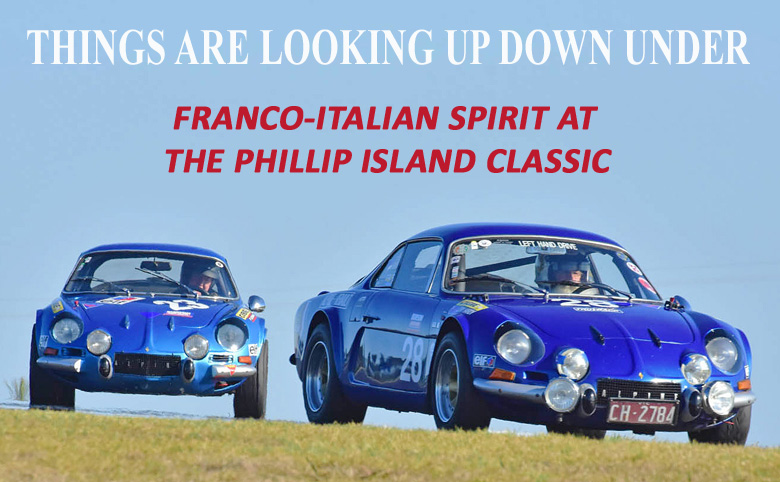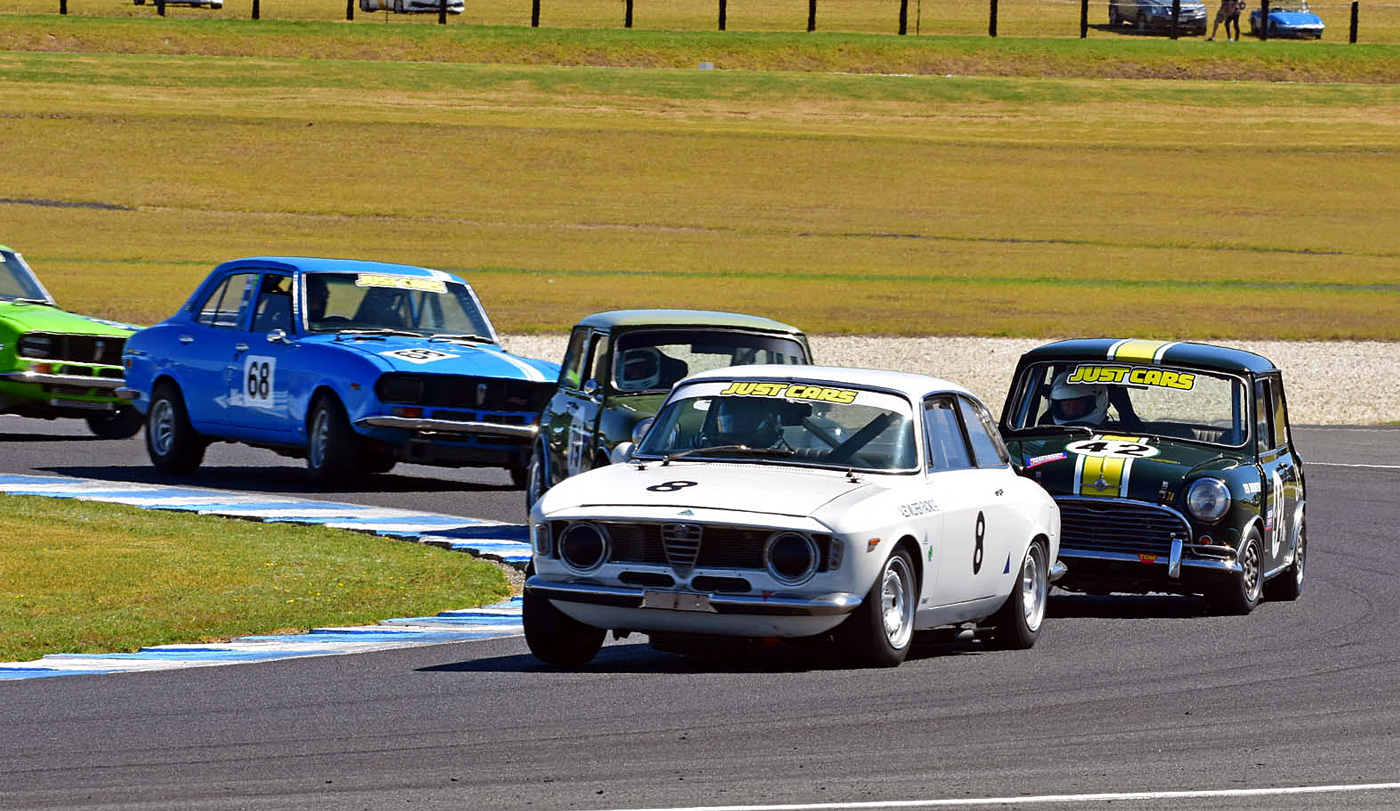Story and photos by Vince Johnson
Phillip Island Classic, Australia, 9-11 March 2018
Australia’s largest historic race meeting, organized by the Victorian Historic Racing Register, is held annually at the flowing Phillip Island circuit south of Melbourne. Decibels were in order all weekend, this year being the 50th anniversary of Formula 5000. Nine cars from New Zealand arrived to contest the International Challenge, reminiscent of the Tasman Series of the 60’s and 70’s where Grand Prix drivers from Europe enjoyed summer sun in the two countries during the northern winter’s off-season.
For Sunday morning’s race Guido Belgiorno-Nettis joined in, his ex-Stefan Johansson 1985 Ferrari 156/85 F1 Turbo managing 3rd place against the 5-liter engines. Tom Tweedie (Chevron B24/28) was unbeatable all weekend. Back in the Groups Q, R and Invited O category, the Ferrari was beaten only in the first of 5 races by multiple Australian racing, sports and touring car champion John Bowe (March 741).
There were others with impressive credentials. Bowe also competed in the Groups J, K, Lb & Formula Vee races in Joe Calleja’s 1952 Allard J2X (chassis #3146). Powered by a 331 Cadillac V8, this car has outright wins to its credit by Carroll Shelby in southern USA and a team win in Buenos Aires. LA dentist Ernie Nagamatsu had brought Old Yeller 2 over, with Shelby and Dan Gurney history, but its 401 Buick gave up on Thursday. Local friends sourced a replacement engine and while it spent most of the weekend in the garage, the car eventually saw time outside on Sunday.
In the same category, 1983 Le Mans winner Vern Schuppan pushed his ex-works 1948 Lago Talbot T26 to 2nd place behind Adam Berryman’s Cooper T70 in Sunday afternoon’s race. This car had spent its first 5 years racing in Europe and the UK with drivers including Mairesse and Chiron, before Doug Whiteford campaigned it in Australia. Norman Falkiner’s Stanguellini FJ ran consistently mid-field while Mal Reid (1959 Faux Pas) took the points in this group with 4 wins.
There were four Alpine Renault A110s side by side in the pits this year, entered in the Regularity runs. Colin Stark’s Group 4 1600S (#23) has World Rally history, one of the factory works team during the 1971, 1972 and 1973 seasons. Colin’s owned the car for 42 years and obviously knows it and the circuit well, taking a 4th place on Friday afternoon.
Alongside it, John Hardy’s 1967 car (#28, also a works spec 1600S) had competed privately in France before being taken to Tahiti. John found it in Noumea in 1995. It had been stored outside, up against a boat where, as he watched, locals used its low front end as a step-up to get aboard. The car looked and ran much better this weekend than on the Pacific island. Completing the foursome were Barry McAdie’s 1969 1300 (#110) and Ernst Luthi’s red 1971 example in which he earned a 2nd on Saturday.
West Australian Steve Boyle arrived from Perth for the Regularity events. His Fiat 125T (see VT 11 April 2017), had been driven over, accompanied this year by his 1969 Lancia Fulvia HF, both being road-registered. Sharing the driving were Robin Rhoades and Iain Simpson. Steve has had the Fulvia since 2014. An original right hand drive version, it had been ordered from the factory by the Italian Trade Commissioner in Australia, the only series 1 HF to be delivered to the WA capital. The Fulvia’s 1584cc twin cam V-four engine develops 114 bhp and the car weighs 830kg. Of the 50 rhd versions built, Steve is aware of 26 remaining. He remarked that his major impression out on the track is its lack of mass.
“The engine is north-south, the transaxle is behind the engine and with equal length drive shafts there’s no torque steer. The rear end is located just as well as the front and it grips. This car doesn’t know what understeer is.” Following the meeting, both cars were driven to the Fiat Nationals at Winton Raceway, 200km (120mi) north of Melbourne. By the time they re-crossed the continent home to the west coast a week later, the round trip had totaled 7,300km (4,500mi).
Also competing in Regularity was Flavio Puccinelli with the one-off prototype 1971 Abarth SE025 Formula Libre/F2 (see VT 12 April 2016 for Flavio’s Lancia Stratos at PI). Developed from the Formula Italia chassis by Abarth designer Mario Colucci, it runs a more highly tuned version of the Fiat Abarth 124 Spyder Rallye Group 4 1756cc, 4 cylinder engine, producing in excess of 170 bhp and coupled to an Abarth-modified Lancia Fulvia 5 speed transaxle. Flavio’s had the car since 2015, prior to which it had spent the previous 40 years in the now closed Maranello Rosso museum in San Marino. After so long on display the car required a full mechanical rebuild that was finished the day before the Phillip Island Classic. As a result the meeting was used to run the engine in and work on setting up the car.
Consistent lap times by three of the Italians in the Regularity runs were rewarded. 2nd places went to the Alfa Romeos of Trevor Montgomery (1928 6C S/C), Trevor McPherson (1969 GT Veloce) and Stephen Callaghan (1973 GTV 2000) while Philip Lewis had Friday’s gremlins in his Dino 206SP (R) sorted for Saturday.
You didn’t have to look far to find other Italians on track. The Group Sc Production Sports entrants were split into 4 classes based on engine size. In the under 2-liters, fifteen of the sixteen entrants were Alfas. Adriano DiMauro’s GTV 2-liter tried hardest but had to settle with four 2nd places to Michael Byrne’s clean sweep in his fast Lotus Seven S4.

Peter Axford, Alfa Giulia Sprint GT, Lyndon McLeod Alfetta GT, and the Phillip Simmie Alfa Giulia Sprint 101.
Dale Ashby’s 1974 Montreal, Phillip Powell’s 1977 Ferrari 308GT4 Dino and Ross Jackson’s 1972 De Tomaso Pantera contested the larger engined classes. Group Sa/b had a 1.8-liter cut-off, putting some of the Alfas against cars up to 3-liters. Among the under 3-liter Historic Touring Cars were Steven Byrnes’ 1965 Alfa Giulia Sprint GTA Corsa and the 1973 GTV 2000 of Martin Piercey.
The two Pro-Sport LM3000 Group C cars entered in Group Q&R Sports among the Lolas, McLarens and others hadn’t been seen before in the country. Both recently imported from the UK by Robin Swift, #22 in Gulf livery was Ford Cosworth DFV-powered while #11, red of course, had Ferrari power. It had been built in 1991 in the UK by Robin Simpson-Smith as a track day car for a customer. Originally fitted with a 348 engine it spent time on European tracks and was later updated with a 355 engine from a road car and raced at Dijon and Brands Hatch. Benjamin Porter and Renato Loberto had the pair consistently in the top 5 over the weekend, the DFV only beaten on Friday by Jason White in the Dutton Garages 8-liter McLaren M8F (#25).
We are told that hybrids and electric cars are the way of the future. Those in the F5000 community don’t seem to be the type to embrace silent racing. And there are petrol-heads with the passion to drive cars that are approaching 50 years old across a continent, compete against other like-minded souls on a racetrack, and then drive them back home, who won’t be staying put until there are charging stations everywhere. We can thank the VHRR that classic and historic car racing is probably safe at the Island for more than a few years yet.
Full results available at http://racing.natsoft.com.au/results/
More photos!



































Another excellent report by our very own South Australian roving reporter and photographer Vince Johnson. Those photos are so amazing that with some imagination you could hear the roar of those well tuned petrol engines, we can only hope electric cars will never make future grids, what a tangle of extension cords that would be. Great to see a couple of our South Aussie club members having a go, Axford and Ashby. Keep the passion going VHRR, well done, again.
Excellent report, Vince.
Outstanding photographs.
Your compendium of precise data has encyclopaedic value.
Janis